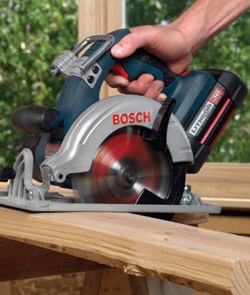Features
Blade Brakes. Perhaps the best feature to be put on a circ saw (besides maybe the blade) is a brake. Having the blade stop its rotation before being lifted off a workpiece is a vital safety feature as well as an efficient time saver. All of the saws, except the Ridgid, have a blade brake. The action of the DeWalt and Milwaukee brakes was noticeably faster than most, while the Hilti’s was relatively slow. The Metabo brake took a long time to act. I didn’t think it even had one at first.
Work Lights. Another useful feature among these saws are cut-line headlamps on the Craftsman, Hitachi, and Makita. These let you line up a cut a little easier when the blade is shaded by the saw’s body before the blade begins spinning. I prefer the trigger-switched designs of the last two. On the Craftsman, the user must manually switch the light on and off, and its slider switch, placed right by the thumb, was constantly getting bumped on by accident.
Fuel Gauges. A battery fuel gauge is a great feature and should be on all batteries. It makes it easy to see the amount of charge left, so a user isn’t ascending a ladder to the roof with a tool that only has a few cuts left in it. The gauge is especially handy with LI batteries, which cut out without much warning when they are discharged. The LI batteries on the 36-volt Bosch, the Craftsman, Hilti, Milwaukee, and Ridgid tools all have this feature. The Metabo also has a fuel gauge, but it is obscured by the saw’s body and must be removed from the tool when you want to check it.
Rip Fences. A rip fence is a minor feature that is included with most of the saws. It’s not typically worth much mention, but the Hilti’s full-length fence with two attachment points is the best I’ve ever seen on a saw. The Hilti saw also can fit onto an accessory straight-edge cutting-guide track for precision cutting–European style.
Rafter Hook. Another welcome feature found only on the Bosch tools is an integrated rafter hook, which stores flat on the top of the tools and flips out when needed. This enhances the portability of a cordless circular saw and is an example of a company really thinking about design features. The same can be said for the cut-line blower on the Makita saw.
Other Points. One feature not so well thought out was the inclusion of a laser guide on the Craftsman saw. Besides being invisible when used outdoors in bright light, I have yet to find a practical use for a laser on a circ saw, other than aiming itself straight at the DIY market.
Also, the toolless blade change gadget on the DeWalt didn’t seem like a benefit. It was harder to use than the simple hex wrench stashed aboard most other saws.
Adjustments
Depth-of-cut setting scales are helpful as an approximate guide for quickly setting the blade depth, and are on all of the saws except the Hitachi and Panasonic. The best and easiest to use was on the Ridgid, with a clear view from the rear of the saw and markings at each 1/4-inch interval. The Metabo also is clearly marked and easy to see, but its scale is in centimeters. Makita took an innovative approach and has markings on the blade guard, which seemed accurate enough and was easy to read. The Craftsman and Milwaukee require you to view hard-to-read depth settings by looking through a narrow area between the handle and the upper blade guard. Hilti’s tool is marked clearly on the saw body but has a similar viewing challenge. The guide on the DeWalt saw proved hard to line up and virtually unreadable, as the battery obscured its view.
All of the saws’ bases tilt to allow a 50-degree bevel cut. The Hilti, Makita, and Ridgid have an override mechanism needed to get to an angle past 45 degrees, and these and the DeWalt all have a positive stop or detent to easily set a 45-degree cut. Markings are made down to the single degree on the DeWalt, Milwaukee, and Ridgid tools, which helps take the guesswork out of finding a specific, desired angle.
The other saws have markings at5-degree intervals, and all have a mark for 22 1/2 degrees.
Every saw can be recalibrated at its 90-degree blade angle stop, and the Makita also can be calibrated at its 45-degree stop.
Winner
The overall winner is the 36-volt Bosch 1671K, because it easily serves both framing and finish needs in one powerful, well-built package. A fast and long-lasting cutter, the battery gave the second most cuts per charge, and the feel and balance of this tool are quite comfortable. The adjustments for bevel cuts and setting the blade depth are easy to use, and the rafter hook is a nice pro touch.
There is no question from this test that the best dedicated framing saw is the Hilti. Contractors probably could put a crew in the field with the Hilti as their primary saw–it’s that good.
For the best trim and siding saw, the Makita fits the bill perfectly. It’s lightweight and compact and has all the right features. Its power and cutting efficiency are high, outperforming the other 18-volt saws. This is the tool that I would take up on the scaffold or use overhead for any trim or siding work.
Next in class come the Milwaukee and Ridgid saws, both good all-around tools, and the Hitachi, which I found to be a nice trim saw.
Following them in preference order are the DeWalt, 18-volt Bosch, Metabo, Craftsman, and the Panasonic.
–Steve Veroneau is a building and remodeling contractor in Falls Church, Va. Michael Springer is senior editor for Tools of the Trade.
